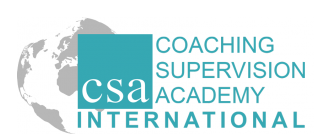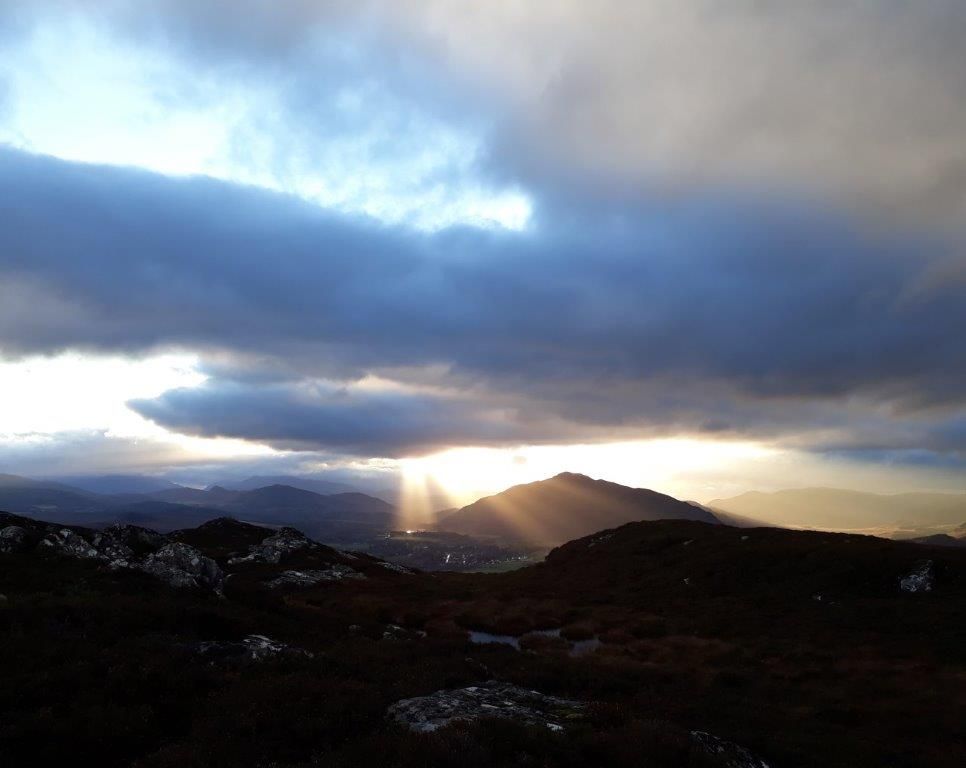Welcome to the CSA Blog
...thoughts and reflections from CSA Faculty, Accredited Supervisors and the Coaching Supervision Community

Deeptime Principles, for those who aren’t familiar, these are principles that connect the larger context of the universe to our personal lives and communities and help us see our lives and our everyday situations from a bigger picture. Stephan Martin, Deeptime Network, first posted in January '24 on our previous site.

THE WORK OF DEVELOPMENT When describing our culture, Native American wisdom keepers sometimes say that, from their perspective, we live in a ‘trance’. I call it ‘culture of absence’, disconnection, ‘narrow bandwidth’ and so on. I like the word ‘trance’. It vividly captures the limitations of the pervading consciousness, including our failure to recognise the trance. In my work with groups and senior leaders, once we touch a certain depth, people start to ‘wake up’; then they say things like “I am beginning to see how actually almost no-one is really listening to anyone” This means that the trance begins to break its hold. Previously they didn’t see this. They were consumed by the trance. That is the state of our culture. We have normalised ‘absence’. It is therefore our calling as leadership consultants and/or coaches, to first of all see/feel the ‘trance’ with ever more clarity, and secondly to do everything in our power break it in ourselves, in order to be real agents of change. The two pillars of development In my work I have come understand, teach and practice the principle that true developmental work, for ourselves and our clients, has to embrace two parallel streams . One stream is a depth of meditative engagement and subtle bodywork practice (yoga, qigong etc). These, not as occasional, part-time palliatives that make our dysfunctional trance feel a little less stressful – the way the corporate world all too often dumbs down the profundity of mindfulness - but rather as committed daily practices that open ever more subtle frequencies and perceptions within us, as they gradually erode the core experience of separation that underpins the culture of ‘absence’. The second stream is in many ways the more demanding and certainly the largely ignored one. Because here we understand through our experience that the first path will be limited by all the unintegrated emotional parts of ourselves - the emotions, personal, transgenerational and collective, that we and our lineage had to ‘exile’ along the way, as vital self-protection, because there was never the possibility of a safe enough holding environment to turn fully towards them. I see, hear and read a lot about ‘managing’ or ‘understanding’ or ‘transforming’ our emotions. And while some of that has a place, it completely misses the fact that, ultimately, no emotion needs fixing, changing or transforming. That mindset keeps us locked in the world of ‘narrative’, of detached conceptualising. Our emotions - our sadnesses, our fears, our anger, our loneliness - ‘simply’ need at a certain moment to be met with a warm, fully embodied, unconditional embrace, in a safe holding context, in order that we can finally stop defending ourselves against them, finally cease the inner tension and fragmentation of pushing them away, and allow the profound process of somatic, energetic metabolising to occur deep in our nervous system. Integration, and a return to wholeness cannot and will never occur through cognition alone . Someone can perfectly understand their core patterns, their adverse childhood experiences, and nothing will change, because the energetic/emotional underpinning of the whole internal structure is not felt/experienced. There is no such thing as ‘negative’ emotion. So long as we buy into that widespread belief, we are still in the linear mind dominated trance, trying to maintain some kind of control, some sense of inner security. In exile. When someone feels safe enough, met and loved enough exactly as they are, to finally stop defending against feelings of hopelessness, helplessness, despair, loneliness for instance, to finally stop trying to get away from or change them, that is exactly where profound inner movement and evolution occur. Where the frozen energy of the previously unfelt emotions naturally transforms itself into life intelligence. Where our core consciousness transforms from scarcity to abundance. And where the fullest expression and fire of purpose and contribution then naturally blossoms. As consultants, we will only be able to meet and hold people in those ‘dark’ spaces to the precise degree that we have met them in ourselves. That is part of our ongoing, lifelong developmental commitment. People who engage only the first stream like to believe that meditation and/or mindfulness ultimately transforms all our negative emotions, our unattended wounds. It doesn't. They say that, as I did for many years of fervent hoping, because they have not yet found the context that allows them to engage the challenges and discomfort of the second stream. It is true, this is very demanding work. Like anything of real value, it asks a lot of us. Actually, it asks everything. Whether in a leader or a coach/consultant this has to become the number one priority. In the times we live in, I believe that nothing else will suffice. The need for more and more individuals and groups and communities to break the trance has surely never been more urgent. I align fully with those who say that our future depends on it. Nicholas Janni www.thematrixdevelopment.com January 2023

All unfelt emotions compromise not only our emotional intelligence and our capacity to relate, empathise and listen, but also diminish the clarity of our critical thinking faculties. I cannot recall a single CEO or senior leader client who has not realised through our work that whole parts of the way they lead, usually the less well-functioning parts, are rooted in their childhood and/or intergenerational trauma. I will begin with some definitions of trauma, and then develop the understanding of the territory and why the title of this article is so important. ********* Although many events are obviously ‘traumatic’, it is more important to understand what happens inside us in the face of difficult events, from the most extreme to what may seem quite innocuous scenarios. A young child feels frightened – what could be more natural? In healthy scenarios, one of the primary caretakers metaphorically and/or literally embraces the child, lets them know that fear is natural, and supports them to feel it within a context of warm, supportive presence. The fear moves through the child’s nervous system, fades, and the child naturally moves on. There has been no need for any internal contraction. There is no ‘after effect’. But mostly, in one way or another the child does not feel supported. Perhaps the parents are busy, perhaps they are themselves caught up in their own traumas and unable to be warm and present for their child. Perhaps they try to explain rationally why there is no need to be afraid. They may even make the child feel stupid for being frightened. Whichever of these, the child has only one option – s/he has to stop or at the very least reduce the intensity of emotional energy inside them because they cannot contain it on their own. This is a survival function. We know instinctively how to do this, it’s in fact quite a remarkable innate intelligence. We basically close down our body, through tension and restriction of the breath. We often also find refuge in thinking. In cases of violence or abuse, people report that they literally leave their body. All of these are essential survival, self-protection strategies. And so we do survive, but at what cost? Because each time we did this – and most of us did it over and over – a part of our life force closed down, went offline as it were. We also started the movement away from the home base of our body in the pelvis. To be grounded, open and rooted was simply too painful. The move way from full embodiment is then supported by our education system which increasingly prioritises data and rational thinking over play and sensuality. As this happens, our overall capacity to feel, and therefore empathise for instance also gradually closes down. Thinking becomes our dominant function, and we forget that thinking by itself does not feel or indeed have any experience of life. And so, 30 to 40 years later, despite all our functional success, as someone rise up the leadership ladder to the point where their humanity and Presence become easily as important as their knowledge, they start getting 360’s telling us that people don’t trust them, that they don’t listen well, that they are perceived as cold, distant and so on. And however much they try to learn new behaviours, these are in the end just band aid until they address the underlying roots. We are all carrying the imprints of unaddressed trauma from our childhoods and from our lineages, often far more subtlely than in the obvious cases of Holocaust or African American descendants, or inhabitants of countries ravaged by war or natural disasters - the fathers who could not express their grief, who were isolated and lonely inside, the mothers who were seething with unexpressed anger, frozen in their sexuality, and so on. I have lost count of how often a client will suddenly see that ‘Oh my goodness, a whole part of how I feel is how my father felt….”, or will realise that much of the way they lead has been shaped by their experience as a five year old. Hence the very unfortunate and dangerous truth that all too often, boardroom behaviour is that of five year olds in the school yard. Working with trauma requires skilled facilitation. It does not need months of therapy if the client is willing. Safe and unconditional space must be generated, so that feelings can be felt without any attempt to manage, fix or change them, and so that the constant escape into narrative, to talking about can be restricted. The work has to move from the cognitive to the experiential for it to bring healing. Everything has to happen first in the body, not the mind. The healing unlocks multiple dimensions of ourselves, including much higher levels of critical thinking. ********** When the word ‘collective’ is used as in the title, the principles remain the same, though we address a wider and bigger systemic field. I believe that the primary collective emotion being experienced now is varying degrees of anxiety. This can relate to everything from personal professional and financial insecurity to the state of one’s country, to the growing global instability, the fact that it is too late to avoid catastrophic climate events, and that we are now constantly on the edge of a war whose progress, including the nuclear possibility, is completely uncertain. Anyone who does not recognise the anxiety levels inside them is basically deeply numb. A senior leader who is emotionally intelligent however is first of all comfortable with their own emotions. Secondly s/he legitimises the emotions of those around. This can be very simple – in a meeting for instance, pausing to acknowledge the anxiety levels in the room, with Presence and empathy, and the owning of their own emotions. “I’m not sleeping well at present, I guess some of you may be feeling the same.” This is what I call robust vulnerability, one of the deepest and most impactful qualities of leadership. When a leader does, this the effect is one of huge relaxation within the individual and group nervous system. I have seen time and time again that, following a moment of such emotional intelligence, new ideas usually start flowing into and through a group in a remarkable way, because the channels are open. Insights, new ideas and new solutions arrive effortlessly – the very epitome of collective ‘flow state’. Conversely, when a leader and a team plough on without stopping to acknowledge emotion, be it grief or fear, it’s as if big boulders are impeding the flow of the river. People remain contracted inside in order not to feel, they think far less clearly, and they very likely leave such meetings feeling more depleted than when they went in. I believe that the growing awareness of trauma in the way I have defined it here, as well as the radical understanding that no emotions are negative, and no emotions need healing, fixing or transforming – that this happens naturally when they are felt and acknowledged in a supportive environment – is a game-changer in corporate culture. It liberates huge amounts of life-energy, and therefore intelligence. Our critical faculties, and our relational connectedness work at their very best when our bodies and hearts are less and less burdened by the contraction of stored, unaddressed emotion. Nicholas Janni www.thematrixdevelopment.com August 2023

Contributed by CSA Accredited Supervisor Wendy Robinson I’ve had a couple of experiences in the last few days which have really made me think. And re-remember that it’s not helpful to separate parts. For example: ‘Here’s me at work and here’s me at home’. ‘Here are the young people and here are the older people.’ ‘Here are the humans, and here are the animals.’ And this has relevance to coaching supervision. My first experience was in conversation with a supervisee. She was talking about a (non-coaching) work experience (team facilitation) and how she had brought along as a guest, a young person, for work experience. The host company had graciously agreed to have the teenager sit in on the session. My supervisee was blown away by the impact this young person had. She quickly realised that her young colleague saw things, felt things, intuited things, that almost made her ‘seem wise beyond her years’. She was open, natural, vulnerable, potent. And the adults in the room were caring and welcoming towards her, and really open to hear her thoughts and feedback. Wow. I thought – ‘Isn’t it wonderful that the presence of someone who isn’t normally part of the status quo in organisations, has such a beautiful impact on the human dynamic within a work team?’ It reminded me of a tiny incident, about 20 years ago. I was concluding a week long, residential leadership programme, with senior leaders from an Oil & Gas company. We’d had a good week – long hours, we’d worked hard and played hard, lots of learnings, lots of good outcomes, but I was utterly exhausted (being the Introvert that I am). As we were starting to pack up our things, 20 people milling round the hotel conference room, saying their goodbyes to each other, a dog ran into the room. A Golden Labrador if memory serves me right.





